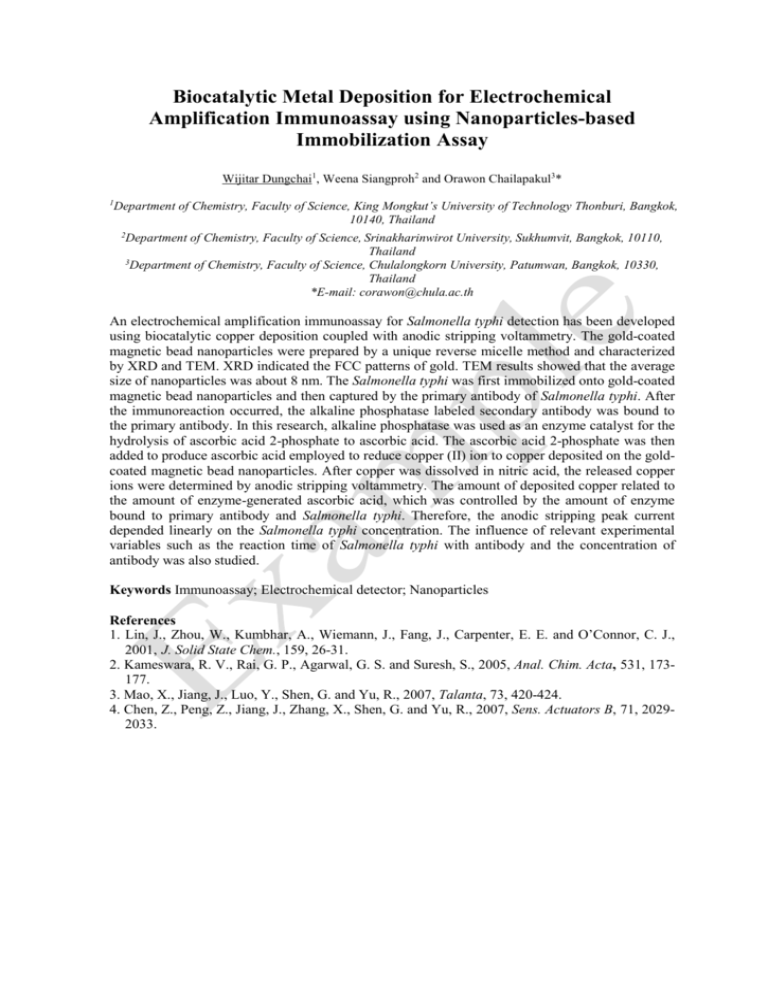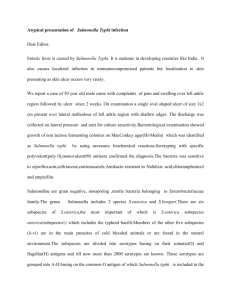Example file
advertisement

Biocatalytic Metal Deposition for Electrochemical Amplification Immunoassay using Nanoparticles-based Immobilization Assay Wijitar Dungchai1, Weena Siangproh2 and Orawon Chailapakul3* Department of Chemistry, Faculty of Science, King Mongkut’s University of Technology Thonburi, Bangkok, 10140, Thailand 1 2 Department of Chemistry, Faculty of Science, Srinakharinwirot University, Sukhumvit, Bangkok, 10110, Thailand 3 Department of Chemistry, Faculty of Science, Chulalongkorn University, Patumwan, Bangkok, 10330, Thailand *E-mail: corawon@chula.ac.th An electrochemical amplification immunoassay for Salmonella typhi detection has been developed using biocatalytic copper deposition coupled with anodic stripping voltammetry. The gold-coated magnetic bead nanoparticles were prepared by a unique reverse micelle method and characterized by XRD and TEM. XRD indicated the FCC patterns of gold. TEM results showed that the average size of nanoparticles was about 8 nm. The Salmonella typhi was first immobilized onto gold-coated magnetic bead nanoparticles and then captured by the primary antibody of Salmonella typhi. After the immunoreaction occurred, the alkaline phosphatase labeled secondary antibody was bound to the primary antibody. In this research, alkaline phosphatase was used as an enzyme catalyst for the hydrolysis of ascorbic acid 2-phosphate to ascorbic acid. The ascorbic acid 2-phosphate was then added to produce ascorbic acid employed to reduce copper (II) ion to copper deposited on the goldcoated magnetic bead nanoparticles. After copper was dissolved in nitric acid, the released copper ions were determined by anodic stripping voltammetry. The amount of deposited copper related to the amount of enzyme-generated ascorbic acid, which was controlled by the amount of enzyme bound to primary antibody and Salmonella typhi. Therefore, the anodic stripping peak current depended linearly on the Salmonella typhi concentration. The influence of relevant experimental variables such as the reaction time of Salmonella typhi with antibody and the concentration of antibody was also studied. Keywords Immunoassay; Electrochemical detector; Nanoparticles References 1. Lin, J., Zhou, W., Kumbhar, A., Wiemann, J., Fang, J., Carpenter, E. E. and O’Connor, C. J., 2001, J. Solid State Chem., 159, 26-31. 2. Kameswara, R. V., Rai, G. P., Agarwal, G. S. and Suresh, S., 2005, Anal. Chim. Acta, 531, 173177. 3. Mao, X., Jiang, J., Luo, Y., Shen, G. and Yu, R., 2007, Talanta, 73, 420-424. 4. Chen, Z., Peng, Z., Jiang, J., Zhang, X., Shen, G. and Yu, R., 2007, Sens. Actuators B, 71, 20292033.











